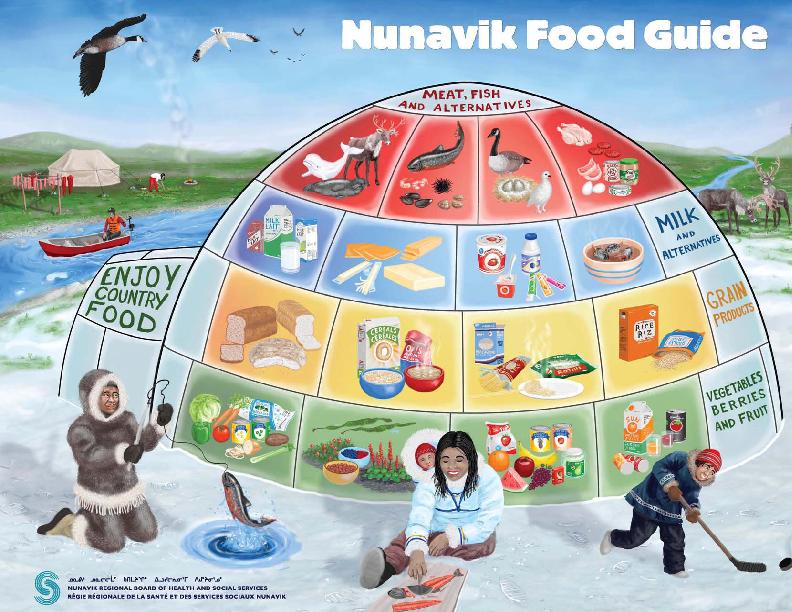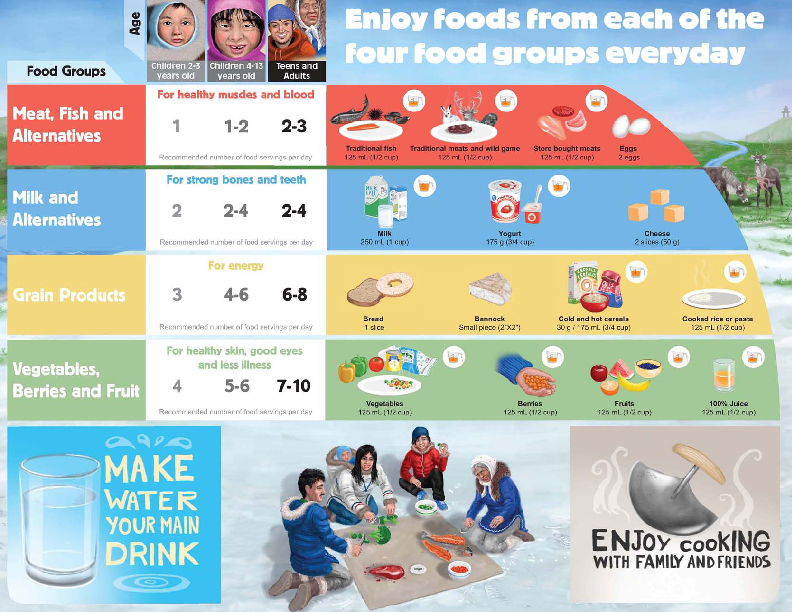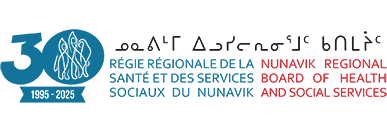Harvesting, sharing and consuming country food is central to Nunavimmiut life. Not only is country food nutritious, but it is also part of identity and cultural continuity. Nowadays, store-bought food is also an important part of the food consumed in the region. Both country food and healthy, store-bought food are part of healthy living.
Healthy eating
Nutrition recommendations
Nutrition tools and factsheets
Recipes
Nunavik Regional Board of Health and Social Services (NRBHSS) support for healthy-eating initiatives
Need support to organize healthy-eating and food-security initiatives? Click here
Healthy Eating
Why Eat Healthy?
The Nunavik Food Guide
Enjoy Country Food
Enjoy Foods from Each of the Four Food Groups Every Day
Vegetables, Berries and Fruit
Grain Products
Milk and Alternatives
Meat, Fish and Alternatives
Why Eat Healthy?
Eating healthy allows you to enjoy a variety of tasty foods that give you the energy and nutritive elements that you need in all your daily activities and to live a healthy life.
Better eating habits help you have more energy and feel better and can reduce the risk of many diseases such as heart disease, type 2 diabetes and some types of cancer.
The Nunavik Food Guide
The Nunavik Food Guide helps people make wise food choices that promote health. It emphasizes the importance of both country food and healthy, store-bought food.
The food guide is for Nunavimmiut aged two years and over and lists the amounts and types of foods recommended every day.
Many Nunavimmiut were consulted during production of the food guide in order to reflect current issues in nutrition and meet the needs of Nunavik’s population.


Enjoy Country Food
Harvesting, sharing and consuming country food are important parts of living in Nunavik communities and contribute to health and well-being.
Unlike store-bought food, all country foods are healthy. Country food provides many nutrients to our body and each part of the animal gives the body different nutritive elements that it needs.
For more information about the nutrients in country food:
Nutrition Fact Sheet Series from Nunavut
Enjoy Foods from Each of the Four Food Groups Every Day
To satisfy different food preferences, each food group of the Nunavik Food Guide includes a wide variety of country food and healthy, store-bought food.
A healthy diet includes foods from each of the four food groups:
- Vegetables, Berries and Fruit;
- Grain Products;
- Milk and Alternatives;
- Meat, Fish and Alternatives.
Each food group supplies a different combination of nutritive elements, vitamins and minerals. That means that eating different foods within each group will help the body get everything it needs to work properly.
In order to create nutritious meals and snacks with the Nunavik Food Guide, it is recommended to try to include:
- three or four different food groups at each meal;
- one or two different food groups at each snack.
Vegetables, Berries and Fruit
Vegetables, Berries and Fruit help the body to fight sickness and infection.
It is important to eat many different vegetables, berries and fruit of various colours because they contain different vitamins and minerals. Fresh, frozen or canned vegetables and fruit are all healthy choices.
Vegetables, berries and fruit help keep eyes and skin healthy because they contain lots of Vitamin A and Vitamin C.
Vitamin A helps you see better in the dark and contributes to healthy skin. It also protects against infection.
Vegetables and fruit rich in vitamin A are usually orange-coloured such as carrots, sweet potatoes, pumpkin, mango and cantaloupes.
Vitamin C keeps the skin healthy and is also important in fighting sickness.
Some vegetables and fruit rich in vitamin C are broccoli, red peppers, tomatoes, wild berries, oranges and strawberries.
Did you know? Berries are rich in antioxidants, which help protect our body against certain diseases. They offer a local and tasty way to protect your health!
Some tips to eat more Vegetables, Berries and Fruits
- Keep your kitchen stocked with quick and easy frozen and canned vegetables and fruit such as frozen broccoli, frozen berries and peaches canned in juice;
- Add vegetables to your soups and stews;
- Add vegetables like peppers, mushrooms, broccoli or zucchini to homemade or frozen pizzas;
- Eat your fruits for dessert such as fruit salad or apple sauce.
Grain Products
Foods in the Grain Products group provide energy for the body.
These foods also provide Vitamin B, which helps the body use this energy.
Choosing high-fibre foods from the Grain Products group, like whole-wheat bread, whole-wheat pasta and high-fibre cereals, is important.
Fibre helps in maintaining healthy weight, keeping our bowels regular, preventing heart disease and certain types of cancer, and lowering our chances of getting type 2 diabetes.
What can I do to get more fibre from foods in the Grain Products group?
- You can replace half the white flour in your bannock with whole-wheat flour, or try adding oatmeal! You can choose whole-wheat bread more often and try cereals made from whole grains such as Bran Flakes®, Shreddies®, Multi Grain Cheerios®, Raisin Bran®, etc.
- You should also try to avoid eating sugary cereals like Froot Loops®, Lucky Charms®, Honeycomb®, etc. These cereals are less healthy because they are high in sugar and low in fibre.
Milk and Alternatives
Foods from the Milk and Alternatives group help the body to build strong bones and teeth.
They contain lots of Calcium and Vitamin D. Calcium helps to build strong bones and teeth and keeps them healthy while vitamin D helps our body to absorb calcium. These foods are very important for everyone, especially pregnant women and children.
Which foods are rich in calcium?
- Country food: fish heads, fish skin and bones, seaweed and bannock.
- Store-bought foods: milk, yogurt and cheese. Powdered milk or UHT milk (e.g., Grand Pré™) are less expensive than fresh milk and just as healthy!
Where to get vitamin D?
- Country food: fish.
- Store-bought foods: milk, some yogurts, non-hydrogenated margarine.
- From the sun!
Many people think cream, coffee creamer (e.g. Coffee Mate®) and butter belong in the Milk and Alternatives food group. This is not true, they are all just fat.
Did you know? Eating cheese after meals can help prevent tooth decay.
How to boost your calcium:
- Yogurt, cheese, milk and flavoured milks make tasty snacks! Try to include these options in your everyday snacks.
- Place an ice-pop stick in yogurt such as Minigo® or Danino®, freeze overnight and remove from container. Enjoy a calcium-rich treat for dessert! Yogurt in tubes can also be frozen in their package.
- Add milk to canned soup, or use milk to make pudding.
Meat, Fish and Alternatives
Foods from the Meat, Fish and Alternatives group help build strong muscles and healthy blood.
They contain lots of Proteins, Iron and Vitamin B12.
Proteins help the body to grow.
Iron helps to build healthy blood to carry oxygen through the body. Iron is especially important for pregnant women, infants and young children.
Vitamin B12 helps to keep our muscles and blood healthy.
A meat alternative is a food that can replace meat or fish such as eggs or nuts because they are rich in proteins like meat and fish.
Tips for healthy choices from the Meat, Fish and Alternatives group
- Traditional (wild) meat, birds and fish are all good and healthy choices.
- When buying meat, choose leaner cuts with less fat.
- Choose these foods less often: bologna, hot dogs, salami, pepperoni, bacon and luncheon meats like Klik®, SPAM® and KAM®. They are very high in fat and salt. Instead, choose sliced ham, chicken or turkey and canned fish.
- Avoid breaded or fried meats like battered fish, fish sticks and chicken nuggets.
Nutrition Recommendations
Babies and Children
From birth to six months of age: Breastfeeding and infant formula
At six months of age: First solid foods
At one year of age
Pregnancy
Iron
Vitamin D
Babies and Children
Babies grow quickly during their first years and they need healthy foods to grow well. From birth to six months, babies need only breast milk and vitamin D drops. At six months of age, they are ready to eat solid foods and they need iron-rich foods every day.
From birth to six months of age, babies need only breast milk and vitamin D drops.
Any quantity of breast milk is beneficial for the baby and the mother. Infant formula with iron is the next-best choice when a baby is not breast-fed.
Breast milk is the best for babies because it:
- has all the nutrients human babies need;
- has antibodies that fight off germs;
- protects against allergies;
- helps with normal weight gain;
- helps brain development.
Breastfeeding is the best for mothers because it:
- helps the mother bond with her baby;
- saves time and money;
- protects against breast cancer and may help strengthen bones;
- helps some mothers to lose weight gained during pregnancy.
For a baby who is not breast-fed or not exclusively breast-fed, it is important to choose infant formula with iron to fulfill the baby’s needs. Switching to low-iron formula does not help babies with constipation. If your baby is constipated, talk to your health professional.
It is better to wait until the baby reaches one year before giving cow’s milk.
Starting at six months of age, babies are ready to eat solid foods and need to eat iron-rich foods every day.
Babies’ bodies are ready for solid food around six months because:
- they are able to chew and swallow solid food;
- their intestines will be ready to handle solid food;
- they are be able to hold their head up and turn away when they are full;
- they have less chance of developing a food allergy.
Every day, babies need breast milk or infant formula with iron, vitamin D drops and iron-rich foods.
Iron-rich foods include:
- wild meat: seal, caribou, clams, mussels;
- store-bought meat: beef, pork, chicken;
- baby cereals.
Eating food containing Vitamin C with iron-rich foods boosts iron absorption!
Vitamin C is mainly found in vegetables and fruit.
- Vegetables: sweet peppers, broccoli, potatoes, tomatoes, etc.
- Fruits: berries, orange and 100% pure orange juice, kiwi, etc.
At one year of age, a child can start to drink whole cow’s milk (3.25%).
- It is recommended not to give more than 25 ounces (750 ml or three 8-ounce sippy cups) of milk per day.
- Too much milk can decrease iron absorption and take the place of healthy food in the stomach.
At one year of age, babies can eat with the whole family. Offer food from the four food groups of the Nunavik Food Guide. Breast-feeding is recommended as long as the mother and the child wish to.
Before the baby reaches the age of four years, be careful with the following foods that may represent a choking risk:
- hot dog pieces;
- whole grapes;
- popcorn;
- nuts and seeds;
- candies;
- raw and hard vegetables;
- chips;
- fish with bones.
Country food and healthy, store-bought food are both part of healthy eating habits for young children.
Pregnancy
Healthy eating during pregnancy is beneficial for both the baby and the mother.
Adopting a healthy lifestyle is important for the baby’s growth and helps the mother to have more energy.
During pregnancy it is recommended to:
- Eat a variety of foods from the four food groups of the Nunavik Food Guide:
- Eat country foods; they are very rich in many nutrients such as iron and vitamin D. Country foods are healthy choices during pregnancy. Beluga meat is the only food item for which consumption should be limited for pregnant women and women of childbearing age because of the mercury it contains. For the rest of the population beluga meat is considered safe.Note that beluga maktak is low in mercury and is full of good nutrients.
- Drink plenty of water.
- Make sure to cook store-bought meat, eggs and seafood properly. Raw or undercooked meat, eggs or seafood may have bacteria that can harm the unborn baby.
- Avoid alcohol.
- Limit caffeine consumption (sources of caffeine include coffee, tea, pop, chocolate and energy drinks).
- Be active, choosing activities you enjoy.
For more information on nutrition during pregnancy: Building Healthy Babies
Iron
Iron is necessary for good health; it carries oxygen in the body, helps fight infections and is essential for the brain.
The main symptoms of iron deficiency are lack of energy, irritability, frequent infections, diminished attention, learning difficulties and slower growth.
Around six months of age, when babies are ready to eat solid food, it is important to serve them iron-rich food every day.
Iron-rich foods:
- country food: seal, caribou, clams, mussels;
- store-bought food: beef, pork, chicken, canned baked beans, breads and cereals, dark leafy greens (seaweed, spinach);
- baby cereals.
Eating food containing Vitamin C with iron-rich foods boosts iron absorption!
- Vitamin C is mainly found in vegetables and fruit.
- Vegetables: sweet peppers, broccoli, potatoes, tomatoes, etc.
- Fruits: berries, orange and 100% pure orange juice, kiwi, etc.
Eating iron-rich foods is important for everyone: babies, children, adults, pregnant women and the elderly!
If you think you or your child might not be getting enough iron from food, see a health professional.
Vitamin D
Vitamin D is important for building strong bones, muscles and teeth. Vitamin D contributes to protects against infections such as colds, flu and tuberculosis.
If babies and small children do not get enough vitamin D, they can get a disease called rickets. Rickets is a painful disease that weakens bones and causes them to curve.
Vitamin D is absorbed from foods and supplements and is also produced by the body when exposed to the sun.
The skin produces vitamin D when exposed to sunlight. However, in Nunavik the sun is not sufficiently intense during seven months of the year (October to April) for production of vitamin D.
Some foods contain Vitamin D. It is recommended to eat foods rich in vitamin D every day:
Country food:
- fish (lake trout, whitefish, Arctic char, etc.)
- fish eggs
- marine mammals (beluga, seal)
- maktak
- birds’ eggs
Store-bought food:
- milk and chocolate milk
- eggs
- canned fish (salmon, tuna, sardines)
- some yogurt
- margarine
- Sunshine
- Fish
- Milk
If you or your child does not eat foods rich in vitamin D every day, consult a health professional.
In some cases, Vitamin D supplements are needed:
- Infants
- People over 50 years old
Consult your health professional.
Nutrition tools and factsheets
Tools
Nunavik Food Guide – educator’s handbook
In-store nutrition promotion
Healthy Food Choices: Grocery-shopping tips for healthy foods
Factsheets
Discovering food with your baby
True and false
Nutrition facts – True or false
Recipes
Here are some simple, tasty and healthy recipes.
Recipes to make with children and the whole family
Cookbooks
External Links:
Nunavik Regional Board of Health and Social Services Nunavik (NRBHSS) support for healthy eating initiatives
In close partnership with local and regional organizations, the NRBHSS supports various community-based and regional initiatives that promote healthy eating, including:
- Community kitchens and cooking activities;
- In-store nutrition promotion;
- Nutrition-education activities in schools, childcare centres or the community;
- Activities to promote or share knowledge about country food;
- Nutrition Month and Country Food Day;
- Breast-feeding Week;
- Nutrition-related activities for pregnant women and young families;
- Group sessions for people living with diabetes.
- Program to promote water in schools (Imatsiaq!)
In 2018, the NRBHSS responded to a request from the Nunavik schools to improve the availability of water and make it more attractive as main beverage for schoolchildren. The Imatsiaq! project was thus born, a joint initiative with the Kativik Ilisarniliriniq School Board. Three pilot schools participated in the project: Kiluutaq (Umiujaq), Tukisiniarvik (Akulivik) and Jaanimmarik (Kuujjuaq). Imatsiaq! will gradually be deployed in the region's other schools over the coming years. We visited the schoolchildren of Kiluutaq and Tukisiniarvik to present Imatsiaq! and its tools as well as to see their reactions.
To know more about the support and funding the NRBHSS can offer for healthy-eating initiatives, consult the following link.
Health-related initiatives are partly funded by the Nutrition North Canada program, the Aboriginal Diabetes Initiative, the Healthy School approach and the Canadian Prenatal Nutrition Program (CPNP).
